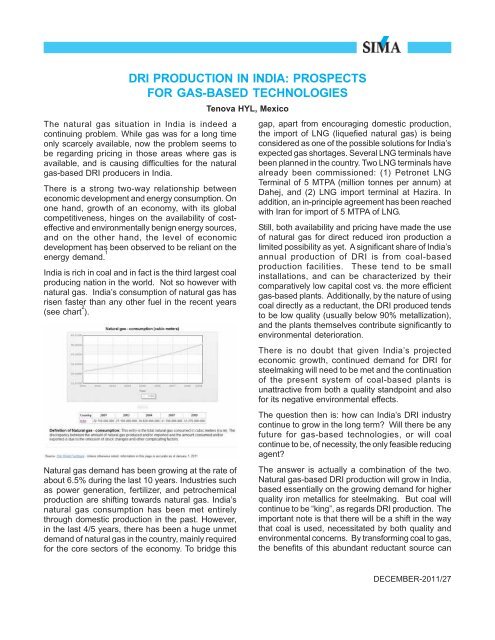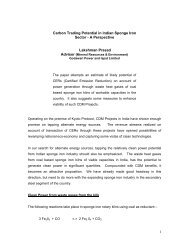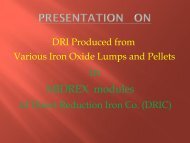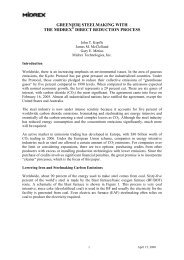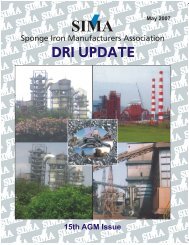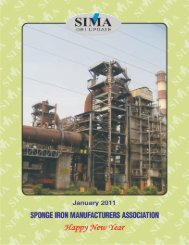December 2011 - SIMA
December 2011 - SIMA
December 2011 - SIMA
You also want an ePaper? Increase the reach of your titles
YUMPU automatically turns print PDFs into web optimized ePapers that Google loves.
DRI PRODUCTION IN INDIA: PROSPECTSFOR GAS-BASED TECHNOLOGIESThe natural gas situation in India is indeed acontinuing problem. While gas was for a long timeonly scarcely available, now the problem seems tobe regarding pricing in those areas where gas isavailable, and is causing difficulties for the naturalgas-based DRI producers in India.There is a strong two-way relationship betweeneconomic development and energy consumption. Onone hand, growth of an economy, with its globalcompetitiveness, hinges on the availability of costeffectiveand environmentally benign energy sources,and on the other hand, the level of economicdevelopment has been observed to be reliant on theenergy demand. 1India is rich in coal and in fact is the third largest coalproducing nation in the world. Not so however withnatural gas. India’s consumption of natural gas hasrisen faster than any other fuel in the recent years(see chart 2 ).Natural gas demand has been growing at the rate ofabout 6.5% during the last 10 years. Industries suchas power generation, fertilizer, and petrochemicalproduction are shifting towards natural gas. India’snatural gas consumption has been met entirelythrough domestic production in the past. However,in the last 4/5 years, there has been a huge unmetdemand of natural gas in the country, mainly requiredfor the core sectors of the economy. To bridge thisTenova HYL, Mexicogap, apart from encouraging domestic production,the import of LNG (liquefied natural gas) is beingconsidered as one of the possible solutions for India’sexpected gas shortages. Several LNG terminals havebeen planned in the country. Two LNG terminals havealready been commissioned: (1) Petronet LNGTerminal of 5 MTPA (million tonnes per annum) atDahej, and (2) LNG import terminal at Hazira. Inaddition, an in-principle agreement has been reachedwith Iran for import of 5 MTPA of LNG.Still, both availability and pricing have made the useof natural gas for direct reduced iron production alimited possibility as yet. A significant share of India’sannual production of DRI is from coal-basedproduction facilities. These tend to be smallinstallations, and can be characterized by theircomparatively low capital cost vs. the more efficientgas-based plants. Additionally, by the nature of usingcoal directly as a reductant, the DRI produced tendsto be low quality (usually below 90% metallization),and the plants themselves contribute significantly toenvironmental deterioration.There is no doubt that given India’s projectedeconomic growth, continued demand for DRI forsteelmaking will need to be met and the continuationof the present system of coal-based plants isunattractive from both a quality standpoint and alsofor its negative environmental effects.The question then is: how can India’s DRI industrycontinue to grow in the long term? Will there be anyfuture for gas-based technologies, or will coalcontinue to be, of necessity, the only feasible reducingagent?The answer is actually a combination of the two.Natural gas-based DRI production will grow in India,based essentially on the growing demand for higherquality iron metallics for steelmaking. But coal willcontinue to be “king”, as regards DRI production. Theimportant note is that there will be a shift in the waythat coal is used, necessitated by both quality andenvironmental concerns. By transforming coal to gas,the benefits of this abundant reductant source canDECEMBER-<strong>2011</strong>/27


